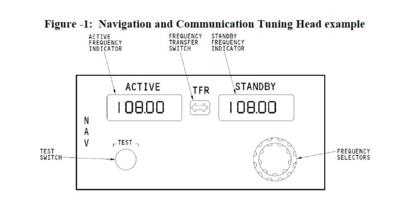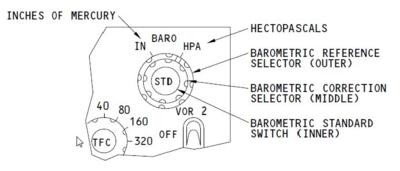Setting Can Be Inadvertently Changed, Agency Says
The FAA has released an Information For Operators bulletin concerning avionics and other aircraft systems equipped with concentrically-centered controls (knobs).

According to the FAA, manufacturers have increasingly equipped avionics and other systems with concentrically-centered controls to conserve limited space in the instrument and control panels of aircraft. Unfortunately a drawback to this type of design is that settings/selections can be inadvertently changed. For example, in one reported incident, rotating the navigation course selection knob resulted in an unintentional change to the barometric altitude setting.
A few examples of common causes of unintentional selections include:
- Mechanical interference between two concentrically-centered knobs;
- Pilot accidentally rotating two knobs at once as a result of finger positioning errors and/or finger slippage; and
- Pilot inadvertently selecting the wrong knob and subsequently fails to make appropriate corrections or fails to detect the inadvertent selection.
Reports from manufacturers and from pilots indicate that these incidents are occurring with some regularity.

Concentrically-centered knobs are typically designed so that the larger outer knob closest to the face of the panel changes cursor position, selects information category, operating/display mode, or large value changes. The smaller inner knob is used to select among the information content, sub categories of the position selected with the larger outer knob, or fine value changes. The most familiar implementation of concentrically-centered control is probably in navigation and communication tuning heads (e.g., to set the frequency in the standby frequency indicator, turn the frequency selectors to set the frequency). The first digit is always 1. The outer knob sets the second two digits (10 MHz and 1MHz) in 1 MHz increments. The inner knob sets the fourth, fifth, and sixth digits (100 kHz, 10 kHz, and 1 kHz) in 25 kHz increments
More complex variations exist, in which multiple and mixed functions are assigned to concentrically-centered controls, or controls with different functions are located near each other (see Figure -2). A change to one function might affect another, totally unrelated function without being detected by the flightcrew.
Operators should report instances of mechanical interference to the appropriate equipment or system manufacturer; or they may submit reports through the Federal Aviation Administration (FAA) Service Difficulty Reporting using a Malfunction or Defect Report Submission Form.
Directors of safety, directors of operations, fractional ownership program managers, training managers, flight instructors, and aircraft owners and pilots should be aware of the potential for inadvertently changing existing, correct selections in avionics and other systems equipped with concentrically-centered controls (knobs). They should collaborate to address that potential in operations and training of flightcrew, stressing diligence in operating concentric controls, and in checking for unintentional changes to unrelated systems.
(Images included with FAA InFO)
 Classic Aero-TV: Remembering Bob Hoover
Classic Aero-TV: Remembering Bob Hoover ANN FAQ: Follow Us On Instagram!
ANN FAQ: Follow Us On Instagram! ANN's Daily Aero-Linx (05.15.24)
ANN's Daily Aero-Linx (05.15.24) ANN's Daily Aero-Term (05.15.24):Altimeter Setting
ANN's Daily Aero-Term (05.15.24):Altimeter Setting Aero-News: Quote of the Day (05.16.24)
Aero-News: Quote of the Day (05.16.24)




